Blending Modification Technology of Insulation Materials for Deep Sea Optoelectronic Composite Cables
Abstract
:1. Introduction
2. Materials and Methods
2.1. Materials
2.2. Mechanical and Physical Properties and Extrusion Performance Test
2.3. Environmental Stress Cracking Resistance Test and Crystalline Characteristics
2.4. DC Performance Test
3. Results
3.1. Mechanical and Extrusion Performance Test
3.2. Environmental Stress Cracking Resistance Test
3.3. Water Blocking Performance Test
3.4. Crystallinity Test
3.5. Space Charge Test
3.6. DC Breakdown and Volume Resistivity Test
4. Discussion
5. Conclusions
Author Contributions
Funding
Data Availability Statement
Conflicts of Interest
References
- Perveen, R.; Kishor, N.; Mohanty, S.R. Off-shore wind farm development: Present status and challenges. Renew. Sustain. Energy Rev. 2014, 29, 780–792. [Google Scholar] [CrossRef]
- Xie, Y.; Wang, C. Spatial pattern of global submarine cable network and identification of strategic pivot and strategic channel. J. Geogr. Sci. 2023, 33, 719–740. [Google Scholar] [CrossRef]
- Ide, S.; Araki, E.; Matsumoto, H. Very broadband strain-rate measurements along a submarine fiber-optic cable off Cape Muroto, Nankai subduction zone, Japan. Earth Planets Space 2021, 73, 63. [Google Scholar] [CrossRef]
- Taga, H.; Nakagawa, S.; Goto, K. An experimental study of transmission distance limitation for the submarine cable system using C-band EDFA repeaters and a demonstration of 96 WDM, 10 Gbit/s, over 12,000 km transmission having sufficient engineering margin. In Proceedings of the OFC 2003 Optical Fiber Communications Conference, Atlanta, GA, USA, 28 March 2003. [Google Scholar]
- Xu, Z.N.; Hu, Z.W.; Zhao, L.J.; Zhang, Y.; Yang, Z.; Hu, S.X.; Li, Y.Q. Application of temperature field modeling in monitoring of optic-electric composite submarine cable with insulation degradation. Measurement 2019, 133, 479–494. [Google Scholar] [CrossRef]
- Asakawa, K.; Kojima, J.; Mitsuzawa, K. Computer simulation of the electric transmission characteristics of LW underwater optical telecommunication cables. In Proceedings of the Europe Oceans 2005, Brest, France, 20–23 June 2005. [Google Scholar]
- Chen, Y.H.; Xiao, S.; Li, D. Stability Analysis Model for Multi-Node Undersea Observation Networks. Simul. Model. Pract. Theory 2019, 97, 101971. [Google Scholar] [CrossRef]
- Guo, Y.; Marin, J.M.; Ashry, I. Submarine optical fiber communication provides an unrealized deep-sea observation network. Sci. Rep. 2023, 13, 15412. [Google Scholar] [CrossRef] [PubMed]
- Chen, Y.; Xiao, S.; Li, D. Flashover discharge model of transmission lines in subsea observation network. Simul. Model. Pract. Theory 2020, 103, 102094. [Google Scholar] [CrossRef]
- Mei, W.; Pan, W.; Chen, T.; Song, G.; Di, J. Research and design of DC500kV optical fiber composite submarine cable. In Proceedings of the 2017 4th IEEE International Conference on Engineering Technologies and Applied Sciences (ICETAS), Salmabad, Bahrain, 29 November–1 December 2017. [Google Scholar]
- Li, D.; Zhou, L.; Wang, X. Effect of Crystallinity of Polyethylene with Different Densities on Breakdown Strength and Conductance Property. Materials 2019, 12, 1746. [Google Scholar] [CrossRef] [PubMed]
- Lustiger, A.; Markham, R.L. Importance of tie molecules in preventing polyethylene fracture under long-term loading conditions. Polymer 1983, 24, 1647–1654. [Google Scholar] [CrossRef]
- Contino, M.; Andena, L.; Valle, V.L. A comparison between K and G approaches for a viscoelastic material: The case of environmental stress cracking of HDPE. Mech. Time-Depend. Mater. 2020, 24, 381–394. [Google Scholar] [CrossRef]
- Chen, Y.; Nie, X.; Zhou, S.; Zou, H.; Liang, M.; Liu, P. Investigations of environmental stress cracking resistance of HDPE/UHMWPE and LDPE/UHMWPE blends. J. Polym. Res. 2013, 20, 1111–1127. [Google Scholar] [CrossRef]
- Parmar, H.B.; Gupta, R.K.; Bhattacharya, S.N. Rheological and molecular properties of organic peroxide induced long chain branching of recycled and virgin high density polyethylene resin. Polym. Eng. Sci. 2009, 49, 1806–1813. [Google Scholar] [CrossRef]
- Ghanbari-Siahkali, A.; Kingshott, P.; Breiby, D.W.; Arleth, L.; Kjellander, C.K.; Almdal, K. Investigating the role of anionic surfactant and polymer morphology on the environmental stress cracking (ESC) of high-density polyethylene. Polym. Degrad. Stab. 2005, 89, 442–453. [Google Scholar] [CrossRef]
- ISO 527-2:1993; Plastics—Determination of Tensile Properties—Part 2: Test Conditions for Moulding and Extrusion Plastics. ISO (International Organization for Standardization): Geneva, Switzerland, 1993.
- ISO 1133:1997; Plastics—Determination of the Melt Mass-Flow Rate (MFR) and the Melt Volume-Flow Rate (MVR) of Thermoplastics. ISO (International Organization for Standardization): Geneva, Switzerland, 1997.
- ISO 11357-7-2022; Plastics—Differential Scanning Calorimetry (DSC)—Part 7: Determination of Crystallization Kinetics. ISO (International Organization for Standardization): Geneva, Switzerland, 2022.
- IEC 60811-4-1:2004; Insulating and Sheathing Materials of Electric and Optical Cables—Common Test Methods—Part 4-1: Methods Specific to Polyethylene and Polypropylene Compounds—Resistance to Environmental Stress Cracking—Measurement of The Melt Flow. IEC (International Electrotechnical Commission): Geneva, Switzerland, 2004.
- Kraus, C.; Carter, L. Seabed recovery following protective burial of subsea cables—Observations from the continental margin. Ocean Eng. 2018, 157, 251–261. [Google Scholar] [CrossRef]
- Zhang, P.; Wang, X.; Yang, J.M.; Zhang, Y.Q. Effect of Acetylated SEBS/PP for Potential HVAC Cable Insulation. Materials 2021, 14, 1811. [Google Scholar] [CrossRef] [PubMed]
- Zhang, K.; Zhong, L.; Gao, J.; Li, L.Z.; Cao, L.; Chen, G. Temperature dependence of crystalline structure and DC performance in LLDPE/HDPE blending material. IEEE Trans. Dielectr. Electr. Insul. 2019, 26, 754–759. [Google Scholar] [CrossRef]
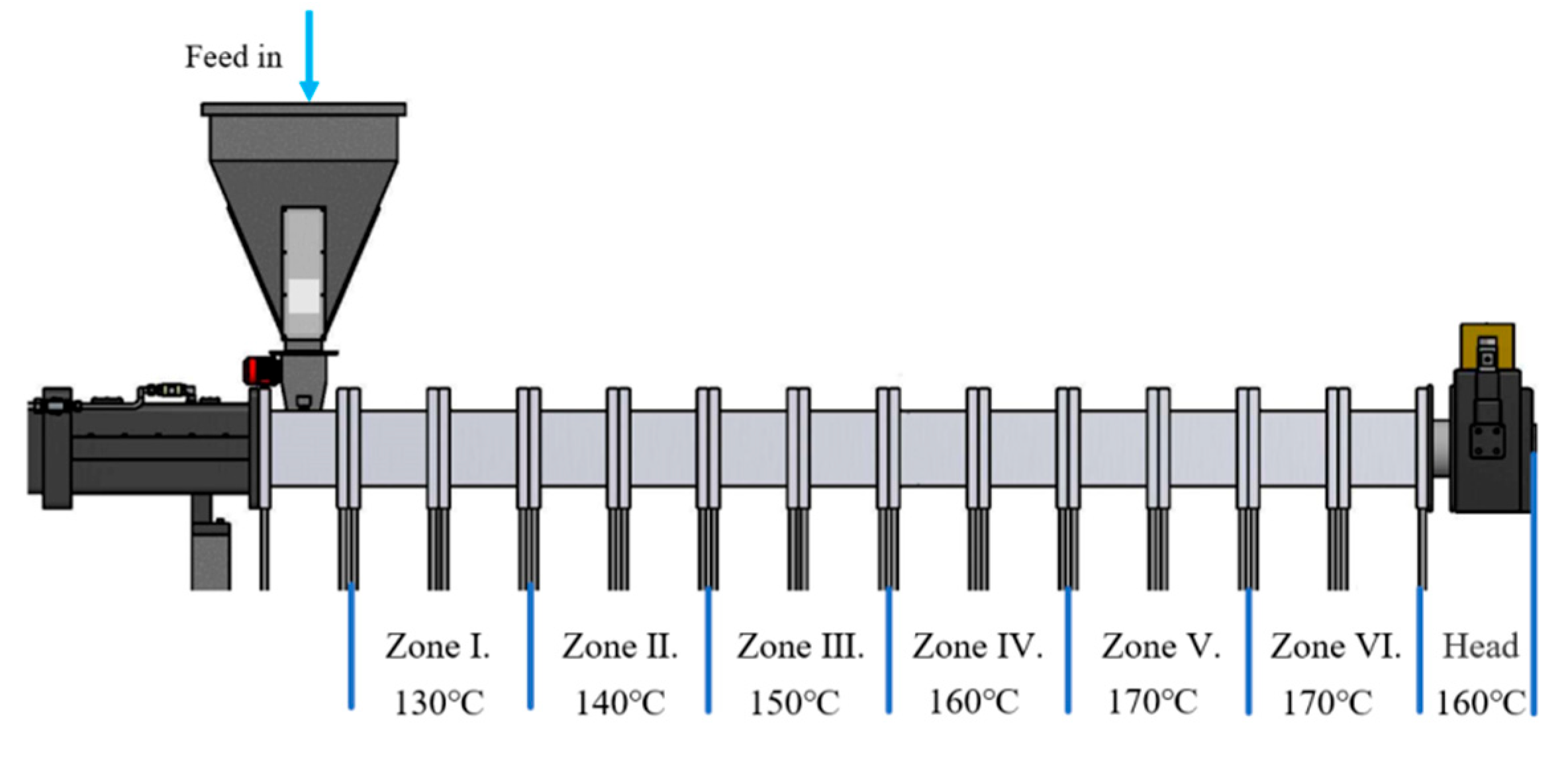
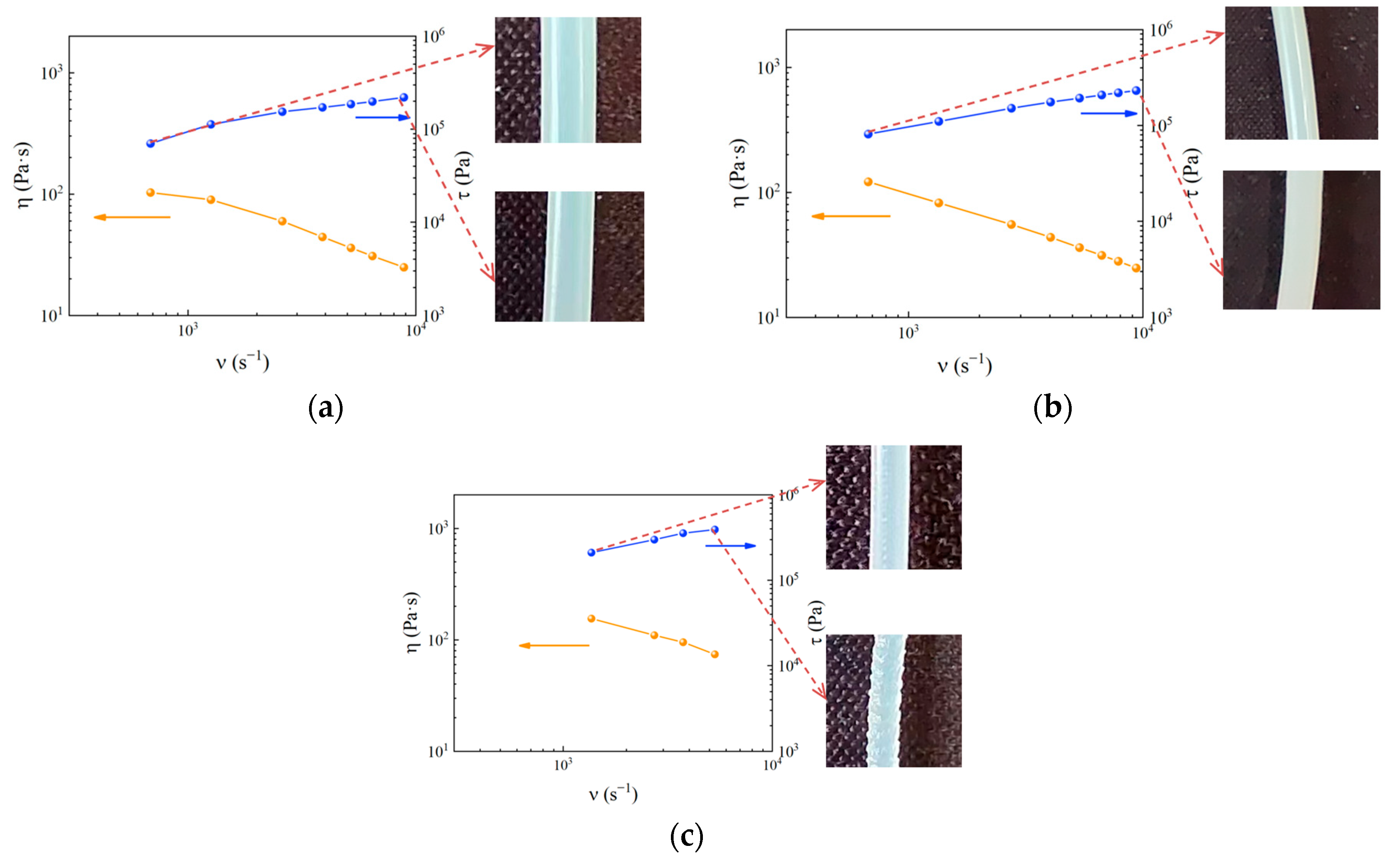
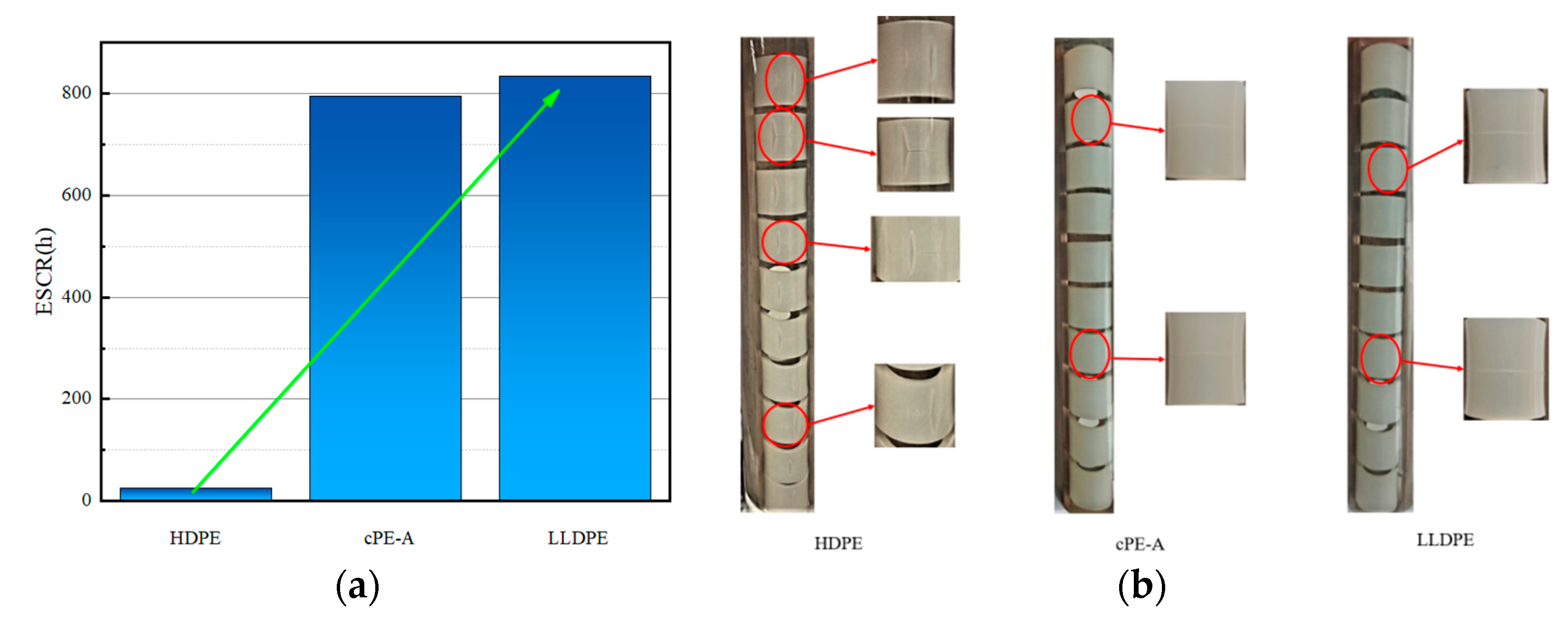
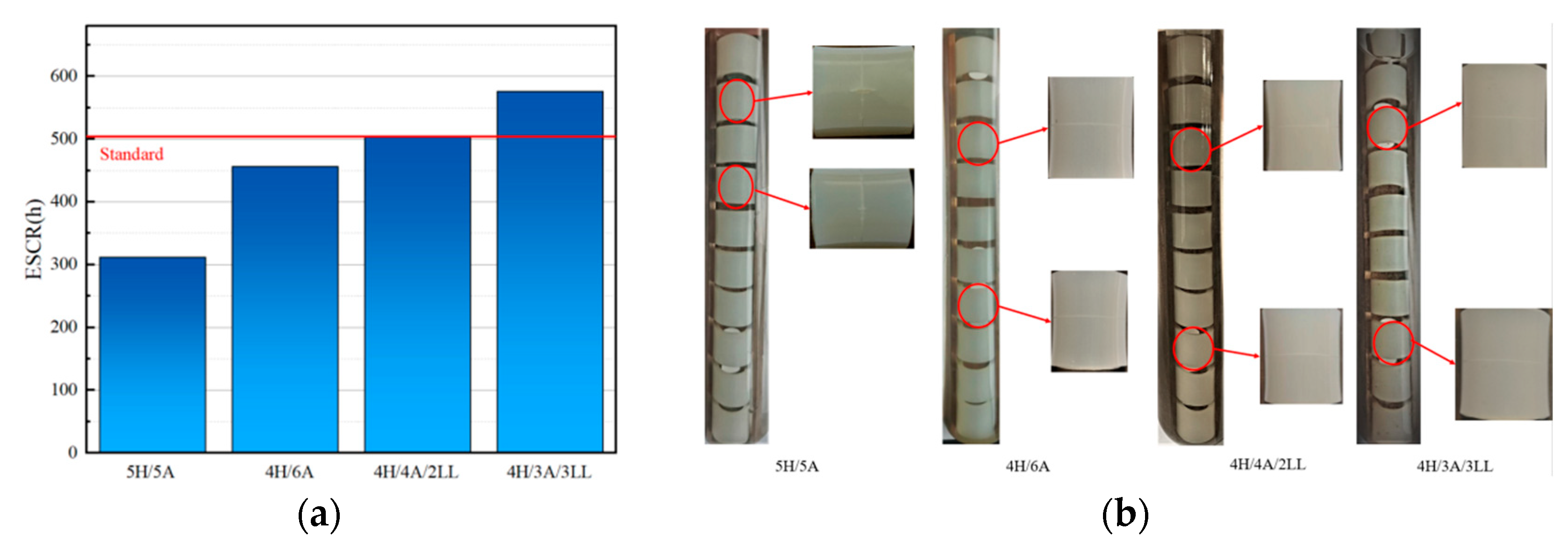
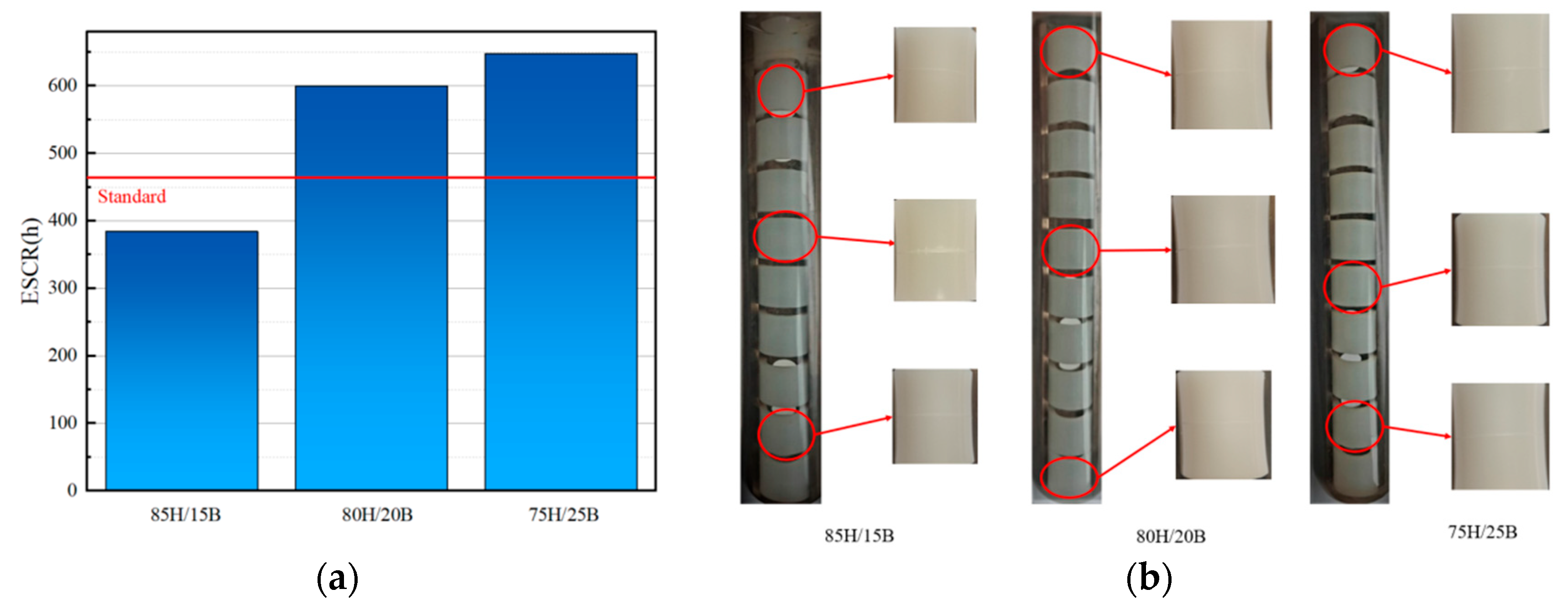

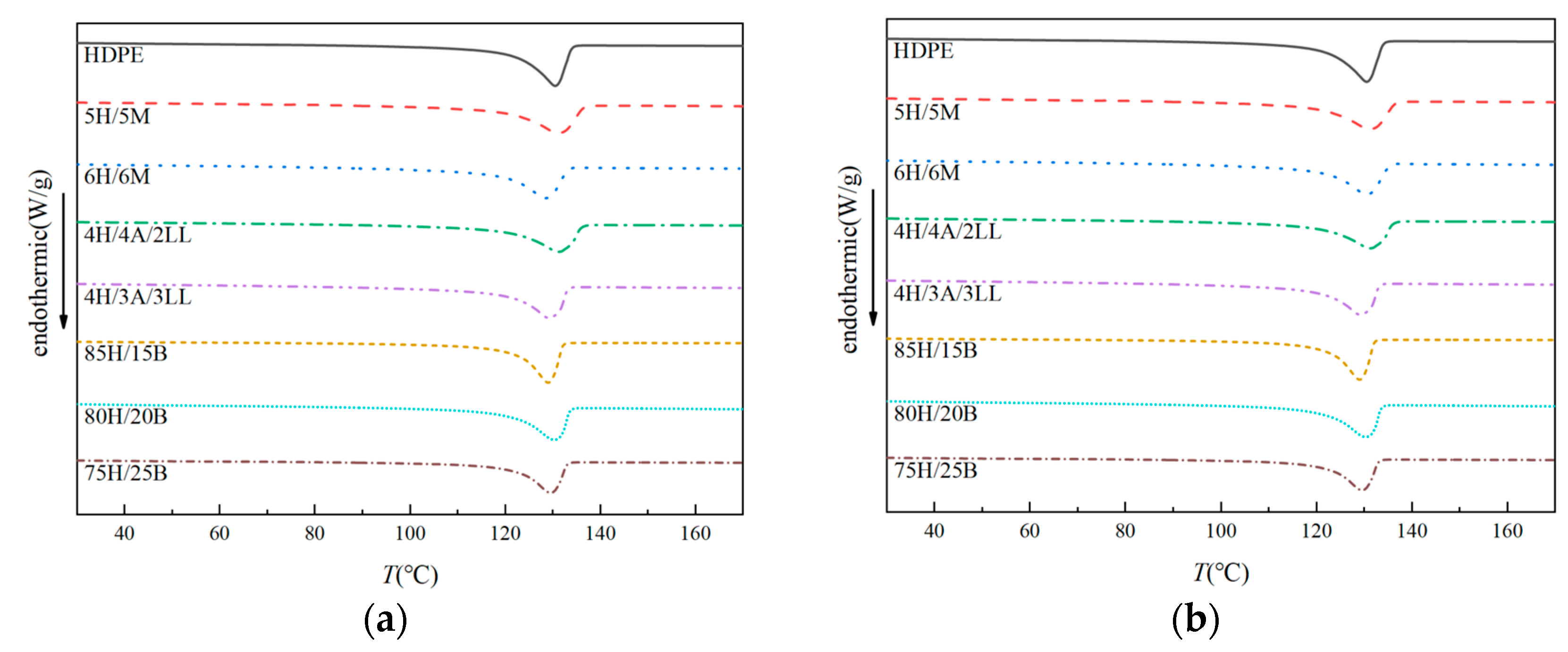

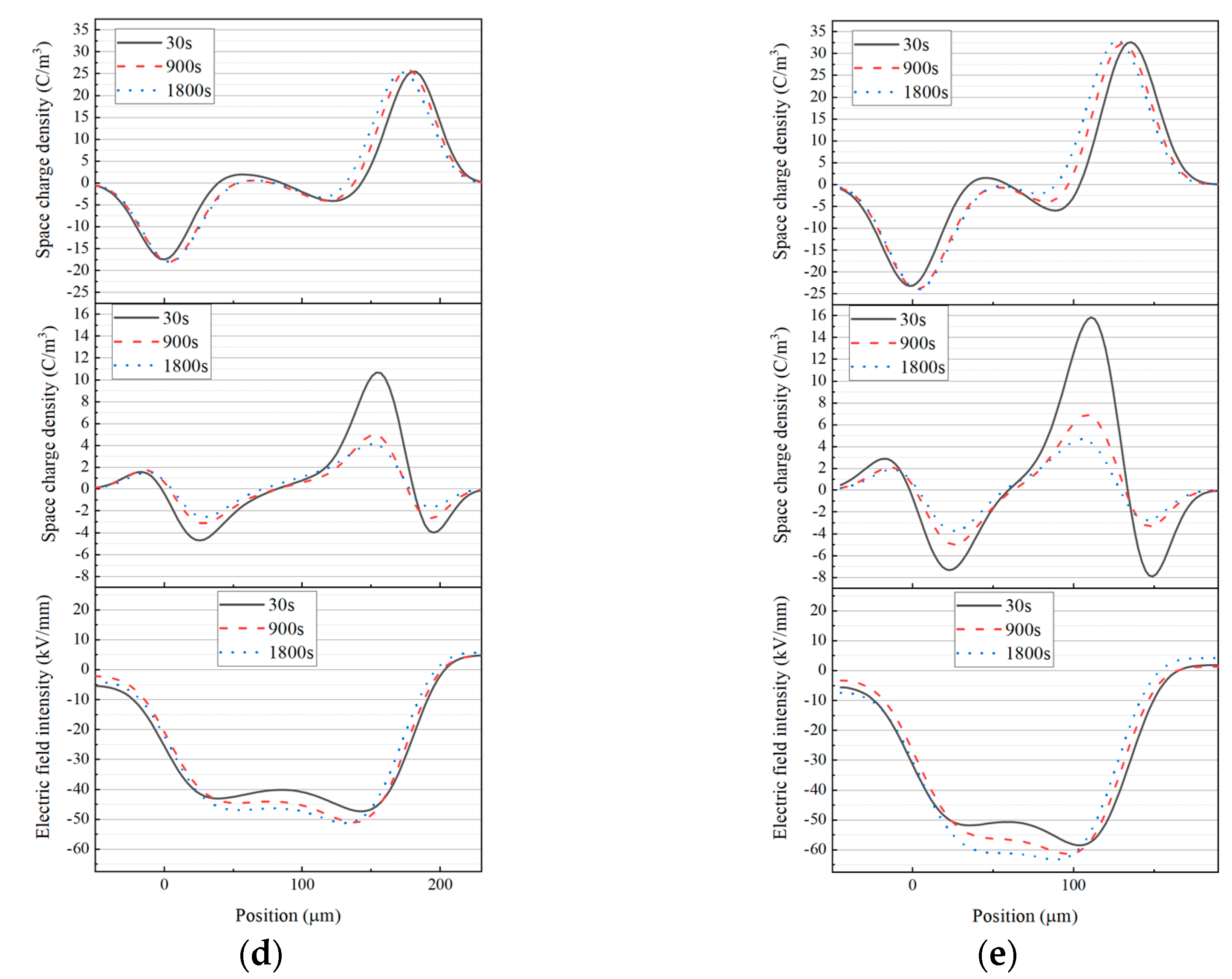
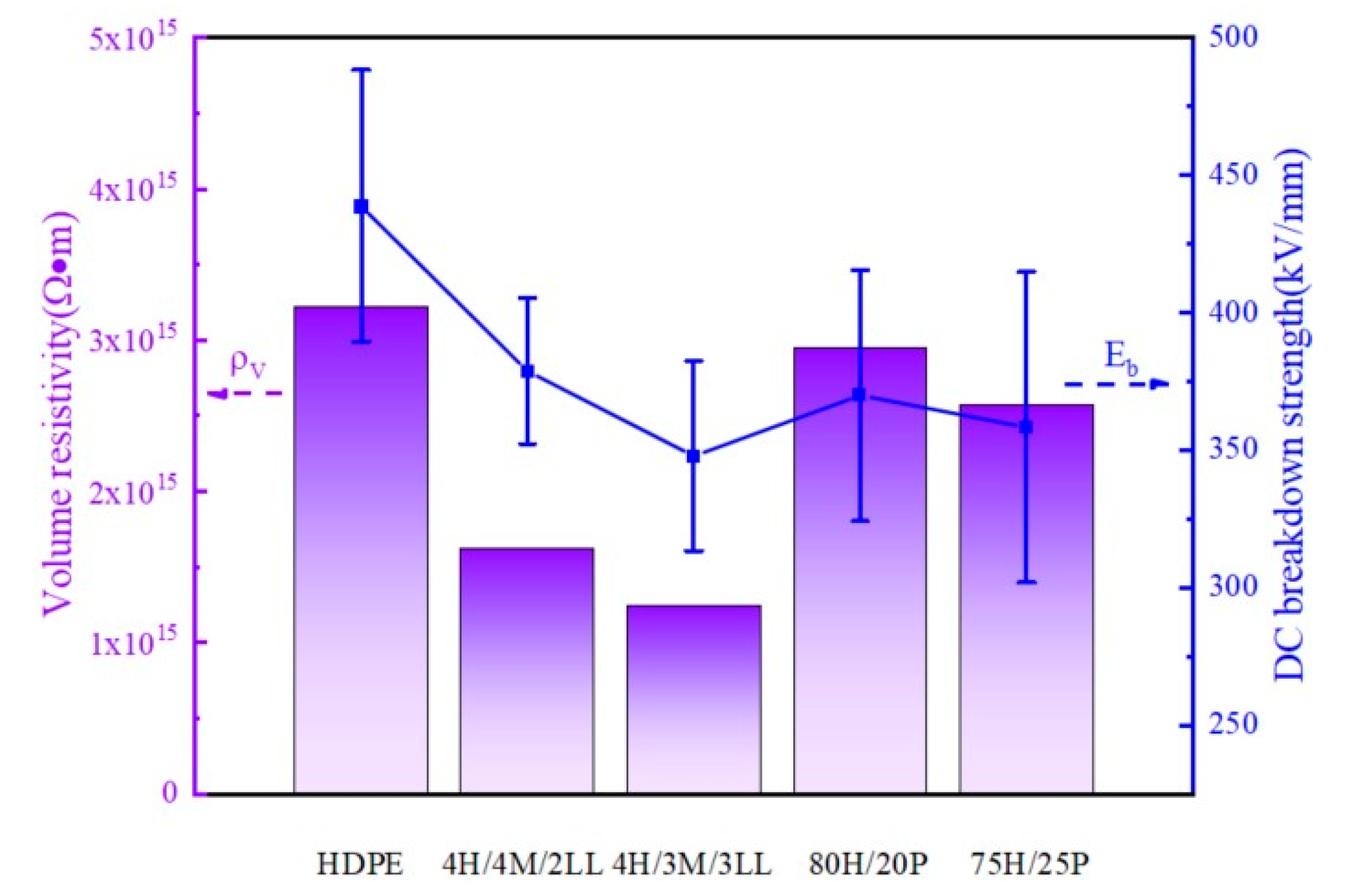
| Materials | HDPE/phr | cPE-A/phr | LLDPE/phr | cPE-B/phr | Irganox 1010/phr |
|---|---|---|---|---|---|
| HDPE | 100 | 0 | 0 | 0 | 0.3 |
| cPE-A | 0 | 100 | 0 | 0 | 0.3 |
| LLDPE | 0 | 0 | 100 | 0 | 0.3 |
| 5H/5A | 50 | 50 | 0 | 0 | 0.3 |
| 4H/6A | 40 | 60 | 0 | 0 | 0.3 |
| 4H/4A/2LL | 40 | 40 | 20 | 0 | 0.3 |
| 4H/3A/3LL | 40 | 30 | 30 | 0 | 0.3 |
| 85H/15B | 85 | 0 | 0 | 15 | 0.3 |
| 80H/20B | 80 | 0 | 0 | 20 | 0.3 |
| 75H/25B | 75 | 0 | 0 | 25 | 0.3 |
| Materias | MI/(g/10 min) | Maximum Extrusion Speed/rpm | Tensile Strength/MPa | Elongation at Break/% | Shore Hardness/HD |
|---|---|---|---|---|---|
| HDPE | 0.7 | >100 | 28.95 | 826.63 | 59.1 |
| cPE-A | 0.7 | 20 | 46.31 | 781.43 | 58.3 |
| LLDPE | 2.1 | >100 | 26.50 | 958.06 | 48.5 |
| 5H/5A | 0.8 | 60 | 39.86 | 816.32 | 58.4 |
| 4H/6A | 0.8 | 50 | 41.23 | 820.45 | 58.2 |
| 4H/4A/2LL | 0.9 | 65 | 34.85 | 807.32 | 57.5 |
| 4H/3A/3LL | 1.0 | 80 | 27.94 | 860.24 | 57.1 |
| 85H/15B | 0.8 | >100 | 27.65 | 928.32 | 56.3 |
| 80H/20B | 0.9 | >100 | 26.19 | 895.65 | 55.4 |
| 75H/25B | 0.9 | >100 | 28.35 | 918.64 | 54.5 |
| Materials | Crystalline Temperature/°C | Melting Temperature/°C | Crystallinity/% |
|---|---|---|---|
| HDPE | 117.21 | 130.67 | 56.88 |
| 5H/5M | 114.69 | 131.35 | 52.31 |
| 4H/6M | 115.43 | 130.66 | 51.87 |
| 4H/4A/2LL | 115.85 | 131.61 | 50.08 |
| 4H/3A/3LL | 116.53 | 129.40 | 51.76 |
| 85H/15B | 117.46 | 129.14 | 50.69 |
| 80H/20B | 116.95 | 130.59 | 48.59 |
| 75H/25B | 117.38 | 129.65 | 41.84 |
Disclaimer/Publisher’s Note: The statements, opinions and data contained in all publications are solely those of the individual author(s) and contributor(s) and not of MDPI and/or the editor(s). MDPI and/or the editor(s) disclaim responsibility for any injury to people or property resulting from any ideas, methods, instructions or products referred to in the content. |
© 2023 by the authors. Licensee MDPI, Basel, Switzerland. This article is an open access article distributed under the terms and conditions of the Creative Commons Attribution (CC BY) license (https://creativecommons.org/licenses/by/4.0/).
Share and Cite
Xie, S.; Chen, Z.; Yan, Z.; Qiu, X.; Hu, M.; Gu, C.; Zhao, X.; Wang, K. Blending Modification Technology of Insulation Materials for Deep Sea Optoelectronic Composite Cables. Energies 2024, 17, 820. https://doi.org/10.3390/en17040820
Xie S, Chen Z, Yan Z, Qiu X, Hu M, Gu C, Zhao X, Wang K. Blending Modification Technology of Insulation Materials for Deep Sea Optoelectronic Composite Cables. Energies. 2024; 17(4):820. https://doi.org/10.3390/en17040820
Chicago/Turabian StyleXie, Shuhong, Zhenzhen Chen, Zhiyu Yan, Xingyu Qiu, Ming Hu, Chunfei Gu, Xindong Zhao, and Kai Wang. 2024. "Blending Modification Technology of Insulation Materials for Deep Sea Optoelectronic Composite Cables" Energies 17, no. 4: 820. https://doi.org/10.3390/en17040820





